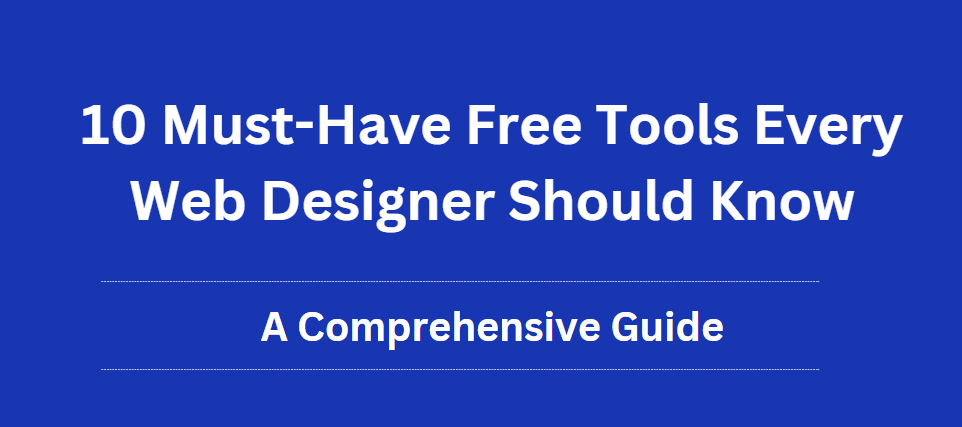A free tool for web designers refers to software or digital resources that are available to users at no cost. These tools are accessible without requiring payment and can encompass a wide range of applications, from productivity software and creative tools to utilities and educational resources. Free tools are often provided under different licensing models, such as open-source licenses or freeware licenses, which govern their usage, modification, and distribution.
Key characteristics of free tools include their affordability, accessibility, and functionality. Despite being free of charge, these tools can offer robust features and capabilities that meet various user needs, making them valuable alternatives to paid software solutions. They are particularly beneficial for individuals and organizations with limited budgets, startups, students, and hobbyists who rely on these tools for personal, educational, or professional purposes.
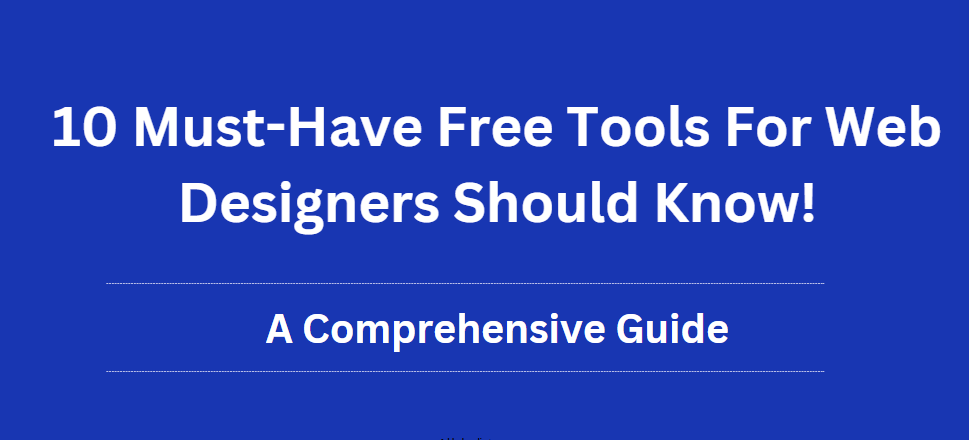
Table of Contents
What is a Free Tool?
A free tool typically refers to software or digital resources that are provided to users at no cost. These tools can encompass a wide range of applications, from productivity software and utilities to creative tools, educational resources, and even programming libraries. Here are some key characteristics and considerations of free tools: Free tools are offered without requiring users to pay any monetary fees. They can be downloaded, used online, or accessed through various platforms without a financial transaction. They are generally accessible to anyone who meets the technical requirements (such as hardware specifications or internet connectivity). This accessibility promotes inclusivity and allows a diverse range of users to benefit from the tools.
Free tools often fall under different licensing models, such as open-source licenses or freeware licenses. These licenses dictate how the software can be used, modified, and distributed, providing legal frameworks that ensure both the developers’ intentions and users’ rights are respected. Despite being free, these tools can offer robust functionality comparable to or sometimes even exceeding that of paid alternatives. This includes features like data management, design capabilities, project management, and more, depending on the tool’s intended purpose.
Benefits of Using Free Tools For Web Designers
Below are some benefits of Free Tools:
- Cost Savings: Free tools for Web Designers eliminate the need for upfront or ongoing costs associated with software licenses or subscriptions. This is particularly advantageous for startups, small businesses, and individuals who may have limited budgets but still need access to essential tools.
- Accessibility: They provide access to technology and resources that might otherwise be financially out of reach. This democratization of technology fosters inclusivity and allows a wider range of users to benefit from digital tools.
- Productivity Enhancement: Many free tools are designed to streamline tasks and improve efficiency. Examples include project management software for better team collaboration and productivity suites for document management and communication.
- Community and Collaboration: Free and open-source tools For Web Designers often have communities of users and developers who contribute to their improvement. This collaborative environment leads to faster updates, bug fixes, and the development of features that cater directly to user needs.
- Risk-Free Evaluation: Users can test the functionality and suitability of tools without any financial commitment. This allows for informed decision-making before investing in premium versions or alternative solutions.
- Innovation and Experimentation: Free tools encourage experimentation and innovation by providing tools and platforms for creative expression and problem-solving. They support a culture of exploration and learning, particularly in fields like software development, design, and content creation.
- Education and Skill Development: They serve as valuable resources for learning and skill development. Students, educators, and professionals can use free tools to practice and master new skills in areas such as programming, graphic design, and data analysis.
- Flexibility and Customization: Free tools for Web Designers often offer customizable features or integrations that allow users to tailor the tool to their specific needs. This flexibility ensures that the tool can adapt to different workflows and requirements.
- Support and Documentation: Many free tools have extensive documentation and support communities where users can find help, troubleshoot issues, and share knowledge. This support network enhances the user experience and reduces downtime or barriers to using the tool effectively.
- Ethical Considerations: Supporting free and open-source software promotes ethical considerations such as transparency, privacy, and user rights. Users can feel confident that their tools are not exploiting their data or compromising their privacy for profit.
What Type of Free Tools For Web Designers Can You Get?
1. Graphic Design Tools
Free Tools For Web Designers are used for creating and editing images, illustrations, and other visual content that will be part of the website’s design.
Examples:
- Adobe Photoshop: Industry standard for photo editing and graphic design.
- GIMP: Free alternative to Photoshop, offering a wide range of image editing tools.
- Adobe Illustrator: Ideal for creating vector graphics.
- Inkscape: Free and open-source vector graphics editor.
2. Prototyping and Wireframing Tools
These tools help in creating wireframes and prototypes to visualize the website’s layout and user interface before actual development.
Examples:
- Figma: Cloud-based design tool for real-time collaboration on wireframes and prototypes.
- Adobe XD: Design and prototyping tool with a focus on user experience.
- Sketch: Popular among macOS users for designing interfaces and creating prototypes.
- Balsamiq: Simple wireframing tool with a focus on low-fidelity designs.
3. Code Editors and Integrated Development Environments (IDEs)
These tools are essential for writing and editing the code that makes up the website. They often include features like syntax highlighting, code completion, and debugging.
Examples:
- Visual Studio Code: Free, open-source code editor with extensive language support and customization options.
- Sublime Text: Lightweight and fast code editor with a rich feature set.
- Atom: Open-source editor is known for its hackability and customization.
- Brackets: Open-source editor with a focus on web development.
4. Content Management Systems (CMS)
CMS tools allow designers to create and manage website content without needing extensive coding knowledge. They are particularly useful for building and maintaining dynamic websites.
Examples:
- WordPress: The most popular CMS, known for its flexibility and extensive plugin ecosystem.
- Joomla: Open-source CMS with a strong community and a range of extensions.
- Drupal: Powerful CMS for more complex and large-scale websites.
5. Front-End Frameworks
These frameworks provide pre-written, standardized code for common web design elements, making it easier to create responsive and visually consistent websites.
Examples:
- Bootstrap: Popular front-end framework with a comprehensive set of CSS and JavaScript components.
- Foundation: A responsive front-end framework is known for its flexibility and customizability.
- Tailwind CSS: Utility-first CSS framework that allows for rapid and consistent styling.
6. Version Control Systems
Version control tools help track changes in the codebase, allowing multiple developers to collaborate efficiently and revert to previous versions if necessary.
Examples:
- Git: Distributed version control system widely used in the development community.
- GitHub: Platform for hosting Git repositories with collaboration features.
- Bitbucket: Another platform for Git repositories, offering both cloud and self-hosted options.
Top 10 Free Tools For Web Designers
1. Figma

Figma is a cloud-baseddesign tool that’s perfect for creating website prototypes and interfaces. It allows for real-time collaboration, making it an excellent choice for teams.
Features
- Real-time Collaboration: Multiple users can work on the same project simultaneously, allowing for seamless teamwork and instant feedback.
- Vector Tools: Create and manipulate vector graphics with precision, ideal for designing detailed and scalable graphics.
- Prototyping: Build interactive prototypes to visualize user flows and test interactions without writing code.
- Design Systems: Create and manage reusable components and styles, ensuring consistency across your designs.
Pros
- Collaboration: Facilitates teamwork with real-time updates and feedback, making it ideal for remote teams.
- Cloud-Based: Access your work from any device with an internet connection, ensuring flexibility and convenience.
- Comprehensive: Combines design, prototyping, and collaboration in one tool, reducing the need for multiple applications.
Cons
- Internet Dependent: Requires an internet connection for full functionality, which can be a drawback in areas with poor connectivity.
- Learning Curve: May be challenging for beginners to grasp all features due to its extensive capabilities.
2. Canva

Canvais a versatile design tool that’s incredibly user-friendly. It’s widely known for creating social media graphics, but it’s also a powerful tool for web design.
Features
- Drag-and-Drop Interface: Easily create designs without advanced design skills, making it accessible for beginners.
- Templates: Access to thousands of customizable templates for various design needs, including web layouts.
- Design Elements: A vast library of photos, icons, and fonts to enhance your designs.
Pros
- Ease of Use: Intuitive interface suitable for beginners and non-designers.
- Versatility: Suitable for various design needs beyond web design, such as social media graphics and marketing materials.
- Collaboration: Share designs and collaborate with team members in real time.
Cons
- Limited Advanced Features: This may not satisfy professional designers’ needs for advanced functionalities.
- Dependency on the Internet: Requires an internet connection to access most features, limiting offline usability.
3. GIMP

GIMP(GNU Image Manipulation Program) is a free alternative to Adobe Photoshop, offering a wide range of tools for photo retouching, image composition, and image authoring.
Features
- Image Editing: Comprehensive tools for photo manipulation and enhancement, including layers, masks, and filters.
- Customizable Interface: Adjust the interface to fit your workflow, with dockable dialogs and multiple windows.
- Third-Party Plugins: Extend functionality with a wide range of plugins available from the community.
Pros
- Powerful Editing Tools: Comparable to professional-grade software, providing extensive image editing capabilities.
- Customizable: Highly adaptable to individual needs with a configurable interface and support for plugins.
- Open Source: Free to use and modify, with a strong community of developers and users.
Cons
- Complex Interface: Steeper learning curve for new users, especially those familiar with more streamlined software.
- Performance Issues: Can be slower than other paid alternatives, particularly when handling large files or complex operations.
4. Inkscape
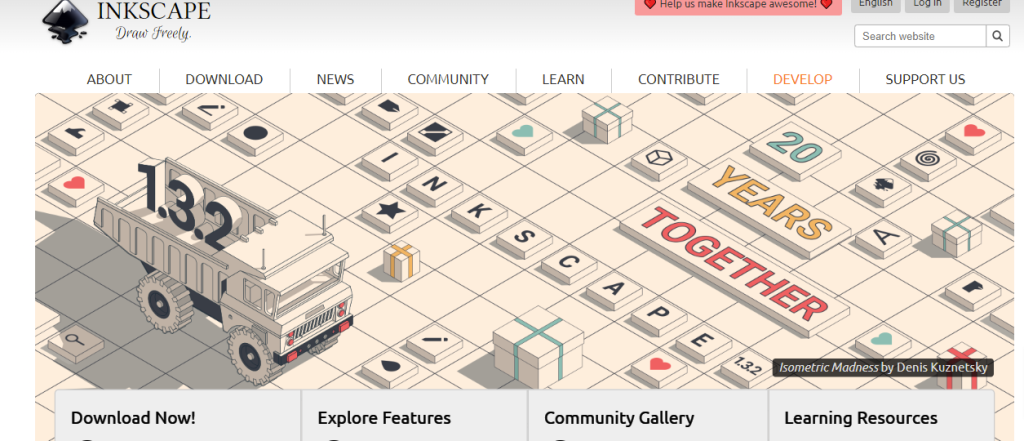
Inkscapeis a Free tool for Web Designers for graphics editors, ideal for creating scalable vector graphics (SVG), which are essential for responsive web design.
Features
- Vector Editing: Advanced tools for creating and editing vector graphics, including paths, shapes, text, markers, clones, and alpha blending.
- Format Support: Supports SVG, PDF, EPS, and AI formats, ensuring compatibility with other design software.
- Extensibility: Extend features with add-ons and plugins, including support for extensions written in Python.
Pros
- Advanced Tools: Comprehensive vector editing capabilities, suitable for detailed and precise graphic design.
- Community Support: Extensive tutorials and active community, providing valuable resources and assistance.
- Free: No cost for full features, making it an accessible option for budget-conscious designers.
Cons
- User Interface: This can be less intuitive compared to commercial alternatives, requiring time to learn.
- Performance: May experience lag with complex graphics or large files, affecting productivity.
5. Google Fonts

Google Fonts is an invaluable resource for free tools for web designers looking to enhance their typography. It offers a vast library of free, open-source fonts.
Features
- Font Library: Extensive collection of free fonts, suitable for various design styles and applications.
- Easy Integration: Simple to integrate with CSS, making it easy to use in web projects.
- Preview Tools: Preview and compare fonts before use, helping designers make informed choices.
Pros
- Free: All fonts are free to use for personal and commercial projects, reducing costs.
- Variety: Wide range of fonts to suit different design needs, from modern to classic styles.
- Compatibility: Works well across different browsers and devices, ensuring consistent typography.
Cons
- Limited Customization: Fonts cannot be customized extensively, limiting flexibility.
- Internet Dependency: Requires internet access to browse and select fonts, restricting offline usage.
6. Font Awesome
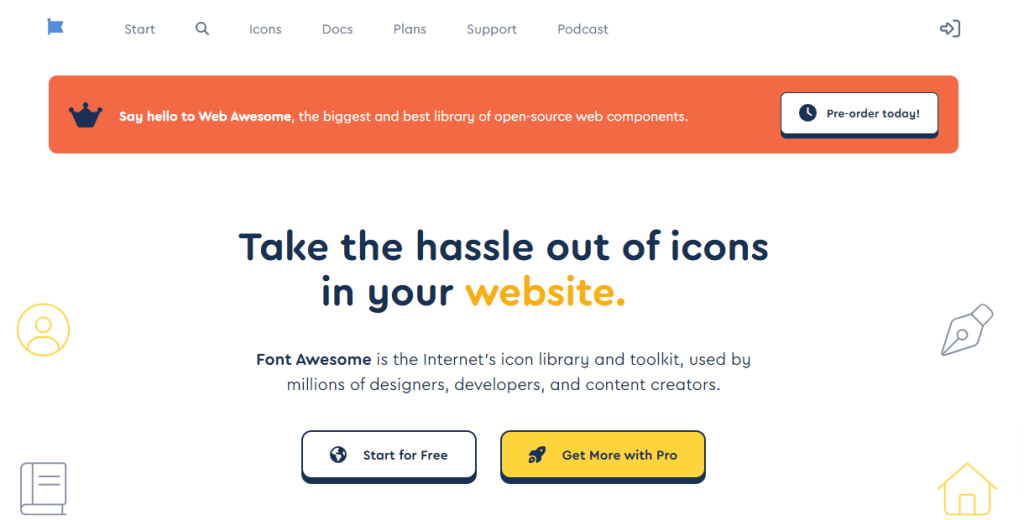
Font Awesome free tool for web designers, provides an extensive collection of scalable vector icons that can be customized with CSS, perfect for enhancing website visuals.
Features
- Icon Library: Large collection of vector icons, covering a wide range of categories.
- Customizable: Easily change color, size, and other properties with CSS, ensuring design flexibility.
- Simple Integration: Easy to include in web projects with a single line of code.
Pros
- Scalable Icons: High-quality icons that scale with screen size, maintaining clarity and sharpness.
- Ease of Use: Simple to integrate and customize, suitable for designers of all skill levels.
- Extensive Collection: Hundreds of icons available for free, covering various design needs.
Cons
- Limited Free Icons: The free version has fewer icons compared to the pro version, which may limit options.
- Dependency on CSS: Requires knowledge of CSS for customization, posing a challenge for beginners.
7. Bootstrap
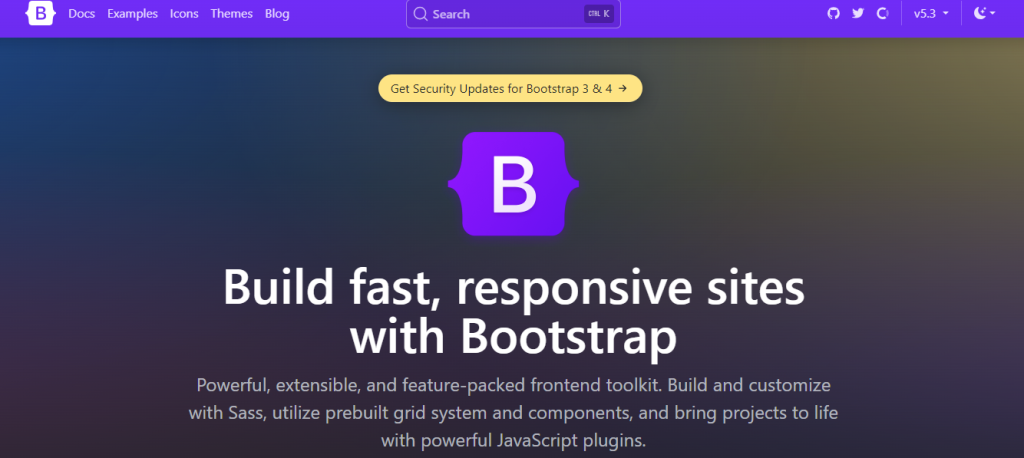
Bootstrapis a free tools for web designers, a popular front-end framework that simplifies the development of responsive websites with a comprehensive set of CSS and JavaScript components.
Features
- Responsive Grid System: Create responsive layouts that adapt to different screen sizes, ensuring a consistent user experience.
- Pre-Styled Components: Includes navigation bars, buttons, forms, and more, speeding up the design process.
- JavaScript Plugins: Add interactive elements with built-in plugins, enhancing website functionality.
Pros
- Responsive Design: Ensures your website looks good on all devices, improving user experience.
- Time-Saving: Pre-styled components speed up the development process, reducing workload.
- Community: Extensive documentation and active community support, providing valuable resources and assistance.
Cons
- Uniformity: Websites can look similar if not customized, reducing uniqueness.
- Learning Curve: Requires time to learn all features and best practices, especially for beginners.
8. Visual Studio Code
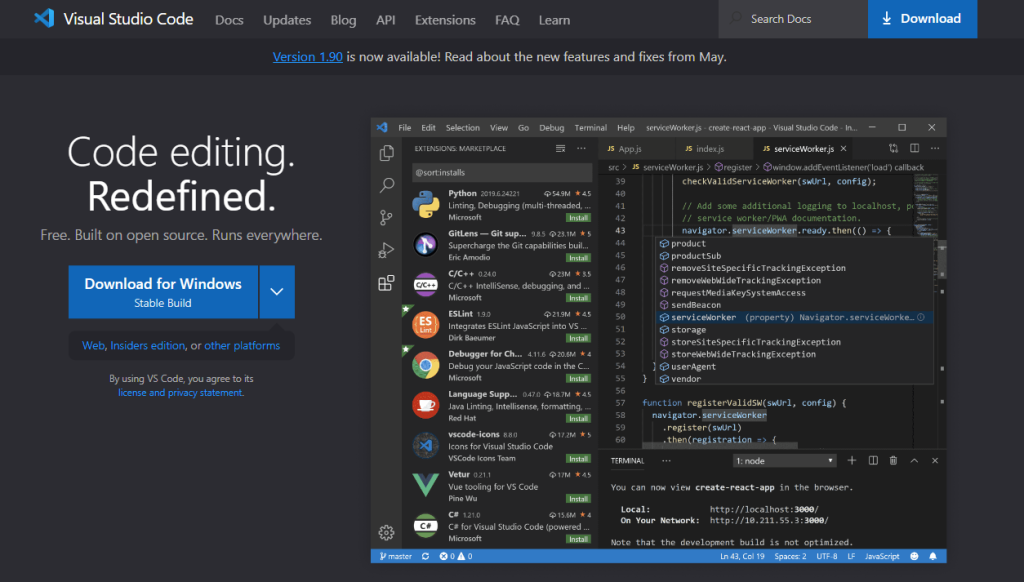
Visual Studio Code (VS Code) is a free tools for web designers, an open-source code editor developed by Microsoft, ideal for web development with its support for various programming languages and frameworks.
Features
- Language Support: Supports a wide range of programming languages, including HTML, CSS, JavaScript, and more.
- Extensions: Extensive library of extensions to enhance functionality, including debugging, linting, and version control.
- Integrated Git: Built-in Git support for version control, facilitating collaboration and code management.
Pros
- Customization: Highly customizable with themes and extensions, allowing for a tailored coding environment.
- Performance: Lightweight and fast, ensuring efficient workflow.
- Community: Active community and frequent updates, providing continuous improvements and support.
Cons
- Complexity: This can be overwhelming for beginners due to its extensive features, requiring time to learn.
- Dependency on Extensions: Some features require additional extensions, which may add to the setup complexity.
9. ColorZilla
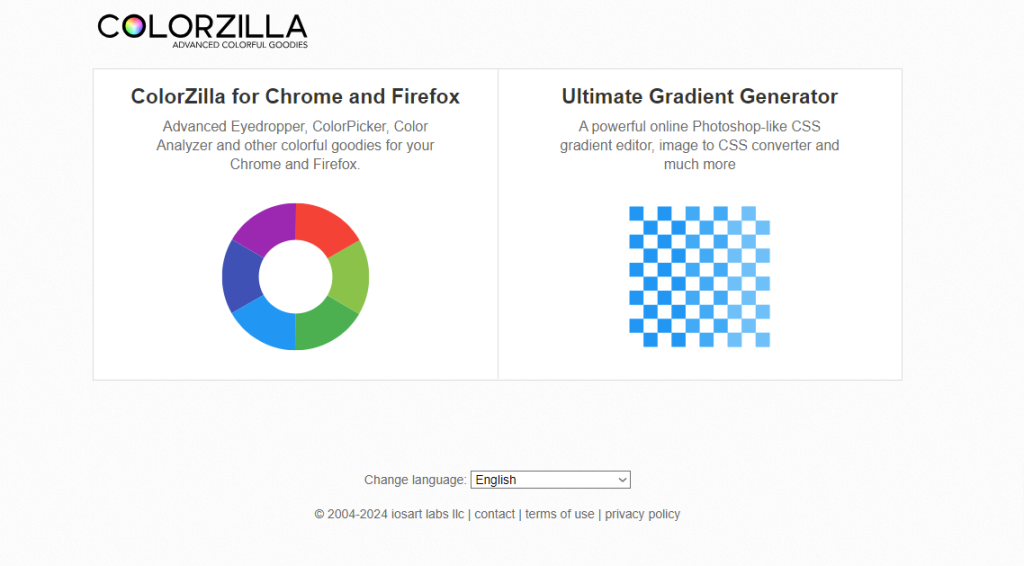
ColorZillais a free tools for web designers, is a browser extension for Chrome and Firefox that offers advanced color tools, making it easy to extract and apply colors directly from web pages.
Features
- Eyedropper: Pick colors from any web page, ensuring accurate color matching.
- Color Picker: Create and save custom colors, facilitating consistent design.
- Gradient Generator: Generate CSS gradients, adding depth and dimension to your designs.
Pros
- Convenience: Easy to use directly from the browser, streamlining color selection.
- Versatile: Useful for color picking, analyzing, and generating gradients, covering various design needs.
- Free: All features are available for free, providing a cost-effective solution.
Cons
- Browser Dependent: Only available as a browser extension, limiting use to supported browsers.
- Limited to Web: Primarily useful for web-related color tasks, restricting application scope.
10. Unsplash
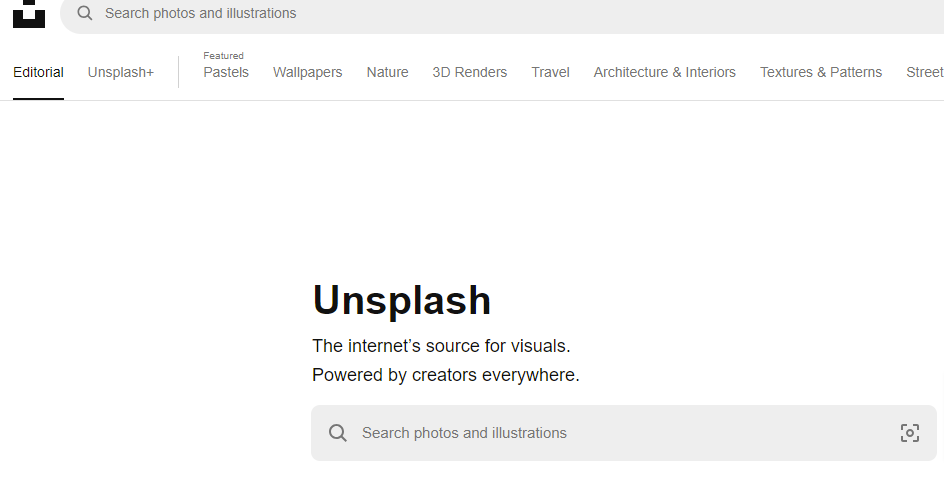
Unsplashprovides a vast library of high-quality, royalty-free images that can be used in web design projects, contributed by a global community of photographers.
Features
- Image Library: Extensive collection of high-quality images, suitable for various design needs.
- Free Use: Images are free for personal and commercial use, reducing costs.
- Easy Search: Simple search and download functionality, ensuring quick access to images.
Pros
- Quality: High-resolution, professional images, enhance the visual appeal of your designs.
- Variety: Wide range of categories and styles, catering to different design themes.
- Cost: Completely free to use, making it an accessible resource.
Cons
- Limited Licensing: Some images may have restrictions on specific uses, requiring careful review of licensing terms.
- Search Limitations: Advanced search features are limited compared to paid stock photo services, affecting search efficiency.
That’s all for Free Tools For Web Designers!
In conclusion, free tools for web designers offer valuable resources that can significantly enhance the design and development process without requiring financial investment. They cater to various aspects of web design, including graphic design, prototyping, coding, project management, analytics, and SEO. While they may have limitations compared to their paid counterparts, such as fewer features, ads, or restricted support, these tools still provide robust functionality for creating professional-quality websites.
Frequently Asked Questions on Free Tools For Web Designers – FAQs
Are free web design tools effective?
Yes, many free web design tools offer robust features that can be highly effective for creating professional-quality websites. However, they may have limitations compared to paid tools in terms of advanced features, support, or customization options.
What types of free tools for Web Designers are available?
Free tools can range from productivity software (like office suites and project management tools) to creative tools (such as graphic design software and video editors), educational resources (like language learning apps and online courses), utilities (such as file converters and antivirus software), and more.
How do free tools for Web Designers make money?
Free tools for Web Designers often have monetization models that include ads, sponsored content, premium versions with additional features, or donations. These monetization methods help sustain the development and maintenance of the free tool.
Are free tools safe to use?
Generally, reputable free tools are safe to use. However, users should download software from trusted sources to avoid malware or security risks. Checking reviews, verifying the developer’s reputation, and scanning downloads for viruses can help ensure safety.
Can free tools be used commercially?
It depends on the tool’s licensing terms. Some free tools are available for both personal and commercial use, while others may have restrictions. Users should review the licensing agreements (often found in the tool’s documentation or website) to determine permitted uses.

